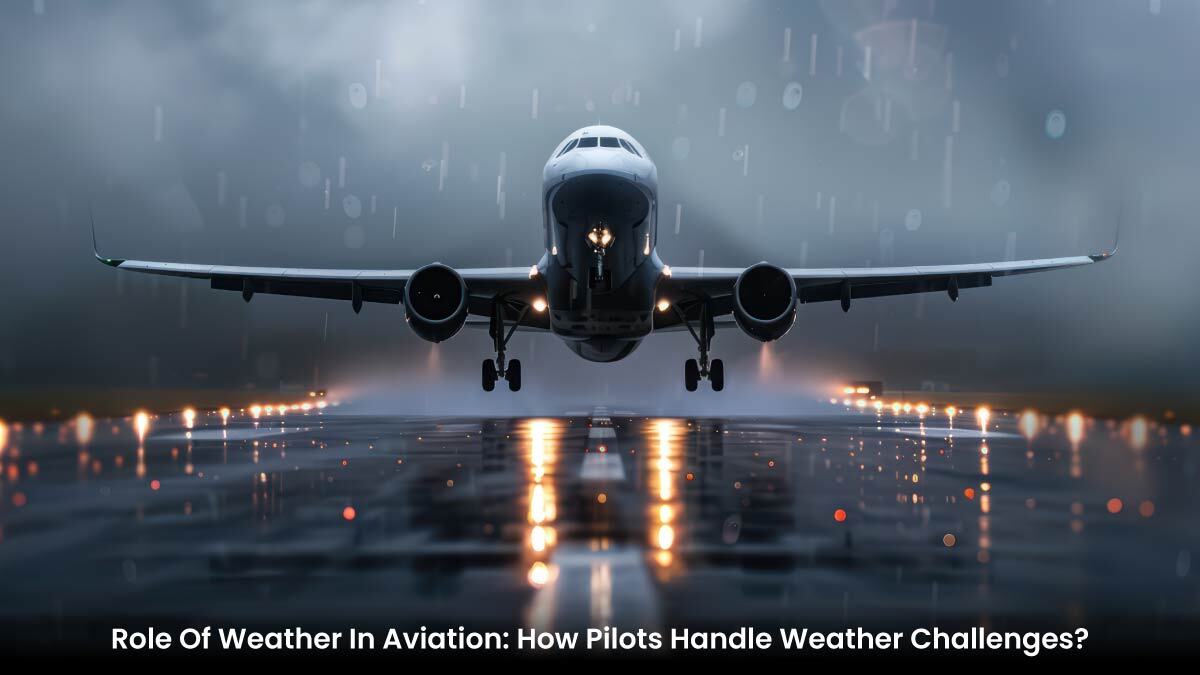
Imagine piloting a plane as a fierce storm brews on the horizon. Dark clouds loom, lightning flashes, and turbulence shakes the cabin. In moments like these, a pilot’s understanding of aviation weather isn’t just part of the job- it’s crucial for ensuring the safety and efficiency of the flight. Weather influences all aspects of aviation, from meticulous flight planning to crucial in-flight decisions. This blog explores how pilots master the dynamic and sometimes daunting challenge of weather, emphasising the critical role of sophisticated weather monitoring tools and the invaluable support from aviation meteorologists.
Understanding Weather Challenges in Aviation
This implies that the weather can greatly affect aviation. Weather factors, including thunderstorms, turbulence and fog, present immense challenges to pilots in that they act as critical barriers to success; hence, a pilot must be able to master the aspect of weather forecasting. Effective handling of these conditions relies heavily on accurate information that is more dependent on real-time information, as well as consultation with aviation meteorologists.
A pilot is faced with a number of decisions when planning a flight and while actually flying, and accurate weather forecasts are important in all those decisions. For instance, the Aviation Weather Center is central in offering various weather reports that assist pilots and airlines in taking appropriate safety measures.
The technologies used in the field of Avionics to Forecast Weather Conditions
Pilots use an array of specialised tools to ensure they have the most accurate and up-to-date weather information:
Weather Radar: Radar equipment is crucial for determining whether it is raining, how intense the storm is, and the direction the storm is going so that the pilot can avoid it.
Satellite Imagery: Provides comprehensive views of weather systems over large areas, which aid the pilot in predicting the changes in the weather far before it actually happen.
Automated Weather Stations: These ground-based stations give continual information on local weather conditions, such as wind, temperature, and humidity, which are important in takeoff and landing procedures.
Pilot Reports (PIREPs): More than just valuable opinions from pilots who are directly affected by the weather, these pieces of information can be used by a lot of readers in modifying their flight plans as needed.
The Aviation Weather Center: Includes items such as SIGMETs (Significant Meteorological Report) and AIRMETs (Airman’s Meteorological Report) that are used to alert pilots of dangerous weather conditions such as severe turbulence, mechanical icing, and low visibility flashes.
All of these tools work together to enable pilots to make safe decisions concerning flying and, overall, increase the safety of flying.
Specialist’s Opinions and Effects of Climate on Aviation Processes
Impact on Flight Operations: The FAA also records that roughly 70% of flight delays are attributed to conditions that are related to the weather. These disruptions cause flight diversions and changes which make weather prediction central in this context.
Pilot Training: In Pilot Training aviation weather data are processed and transmitted to pilots with accurate interpretations by offering some training to them. According to the surveys, the majority of the pilots, 85% of them, believed that specialised weather training has significantly improved their ability to deal with unfavourable weather conditions.
Real-World Case Studies of Weather Management
Handling Snowstorms at Chicago O’Hare International Airport: Chicago O’Hare faces diverse weather, including severe snowstorms. For instance, the proactive cancellation of flights during anticipated ice storms and blizzards has minimised disruptions significantly.
Navigating Microbursts at Columbia Metropolitan Airport: This airport is prone to sudden microbursts and lightning strikes. Enhanced structural reinforcements and comprehensive insurance cover frequent weather-related challenges effectively.
Tackling Ice Storms at Dallas/Fort Worth International Airport: DFW enhances its response to ice storms with improved snow and ice removal strategies and strong airline partnerships, ensuring operational continuity during severe weather.
Technological Advances and Collaboration
Technological Advances: Implementing weather data services reduces weather-related airport delays, which proves that technology is a helpful tool in increasing safety and productivity.
Collaboration with Meteorologists: Close coordination between the pilots and the aviation meteorologists is very essential. A brief on weather conditions is crucial, as 90% of the respondents said that accurate predictions of weather trends have a major impact on the plan and time of the flight.
Strategies for Managing Weather Challenges
Pilots and airlines use sophisticated strategies to manage weather-related challenges:
Pre-flight Planning: Done through briefings and particularly detailed weather briefings, one is made to understand which areas may safely be flown.
In-flight Adjustments: It is about the capability to track the availability of all the pathways in real-time and also enable changes of routes in real-time.
Collaboration with ATC: Regular contact with air traffic control is crucial, especially given the change in weather conditions.
Future of Weather Technology in Aviation
Future technological enhancements may improve weather prediction. AI and machine learning will transform how numerical values from the weather improve safety and flight speed.
Conclusion
Aviation weather is an essential aspect that pilots need to handle to enhance safety and improve the organisation’s operations. Thus, in light of continuous technological progress and improvements in the respective training courses, pilots are in a better position to address weather issues than before.
FAQs
Q. What tools do pilots use to monitor weather?
A. Weather radars, Aviation Weather Center forecast information, and pilot reports or PIREPs are some of the tools used by pilots.
Q. Is there organised and systematic management of weather by the Air Traffic Control?
A. ATC communicates with the pilots to inform them of current weather conditions and helps them change the flight path to avoid such conditions.
Q. What is WIND SHEAR, and how do pilots deal with WINDSHEAR? A. Wind shear is also known as abrupt changes in wind velocity and direction. Pilots address wind shear by using onboard technology that accurately discerns the conditions and adheres to certain recommended procedures, which allow the pilot to change the approach or arrival path to the airport.

